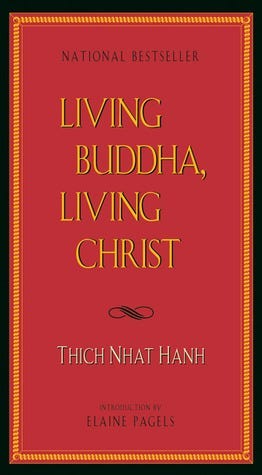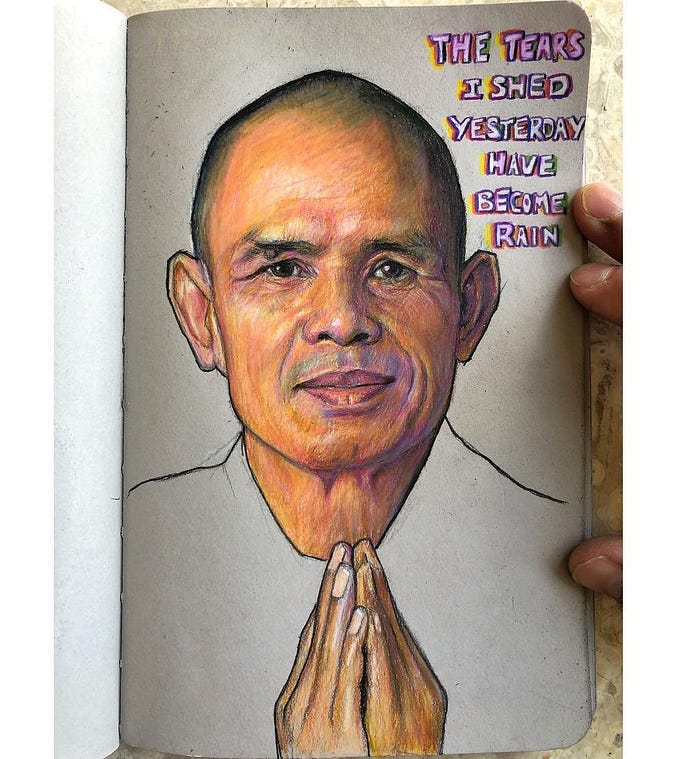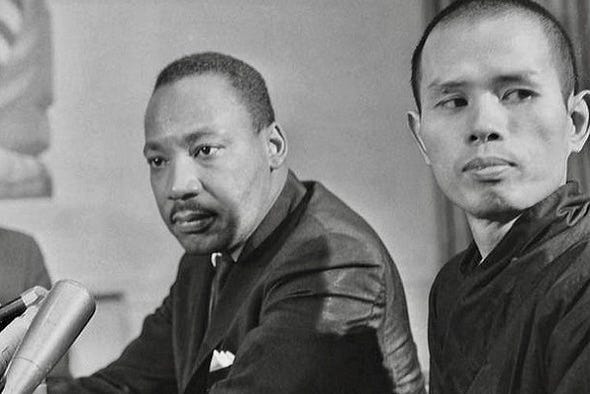[I’m currently finishing a gargantuan project involving mindfulness meditation and the American school system. If you work with teachers or students, or have the slightest curiosity about this work, check us out here. My two collaborators and I are practically devotees of the late great Zen Master Thích Nhất Hạnh, whose teachings are, perhaps unsurprisingly, gushing into this project. I’m thrilled to share that our humble program for teachers, the upcoming “Aware Educator”, will be in its first school before the end of the year—and so it feels right to re-share my brief tribute to “Thay”: a piece I wrote with some moist eyeballs on the day of his death in January 2022. May all beings be at peace. -Bob]
I was lucky enough to have open-minded parents in Texas. Not only did my mom & dad not disapprove of my early interfaith inquiries, they both encouraged me to learn about spiritual traditions outside of American Christianity, the religion of their parents. So thankfully yes, I was that teenager reading Living Buddha, Living Christ by the great, as of today, late Buddhist Zen master Thích Nhất Hạnh.

When I read that book I felt a mix of both excitement and relief. These two ancient teachers whom I deeply respected, were actually not that different. The core message of both—the man sitting under the Bodhi tree and the man teaching in the hills of Galilee—was love. According to this modern master, they were telling us to be present. To be peaceful. And to generate sincere compassion for all beings.
I never really stopped reading about them, or stopped contemplating the teachings of “Thay”, as he was affectionately known by his students and admirers.
“The mind can go in a thousand directions, but on this beautiful path, I walk in peace.
With each step, the wind blows.
With each step, a flower blooms.”
— Thích Nhất Hạnh
Thích Nhất Hạnh was a giant of spiritual wisdom. I’ve lovingly referred to him as a ‘Vietnamese Yoda’, and I cracked up seeing that comparison by one of his monks in a beautiful film about his Plum Village monastery, called Walk With Me. He wrote over a hundred books. He taught into his 90s. And his insights penetrate you to the core. His teachings are a window into the present moment.

Thay was also a living example of the social action that generates from true spirituality. Mindfulness isn’t about being apathetic—by being fully present, we can be more effective in the world in a compassionate way.
He was expelled from Vietnam in 1966 for organizing protests of the Vietnam War. He befriended modern history’s greatest American, MLK, and encouraged King to lend his international voice to help resolve the conflict. Thích Nhất Hạnh is the only human in existence to be nominated for a Nobel Peace Prize by Martin Luther King Jr.
“We often think of peace as the absence of war, that if powerful countries would reduce their weapon arsenals, we could have peace. But if we look deeply into the weapons, we see our own minds—our own prejudices, fears and ignorance. Even if we transport all the bombs to the moon, the roots of war and the roots of bombs are still there, in our hearts and minds, and sooner or later we will make new bombs. To work for peace is to uproot war from ourselves and from the hearts of men and women.”

In one of the best Thích Nhất Hạnh interviews online, another cherished & now-gone spiritual figure, Ram Dass, asks Thay about anger & social action.
Ram Dass asks:
“Many people who are activists, whose heart hurts because of the pain of injustice or the pain of the environment often say to me, that the attempt to be mindful of one’s anger, and hold it tenderly, will dissipate the energy of the anger that they use for social action. Will you talk about that issue?”
The Zen master responds:
“The energy of anger may be a source of energy, but when you use anger as energy, there may be danger. Because when you are angry, you are not lucid. You may say things or you may do things that can be very destructive. That’s why it’s better to use other forms of energy. Like the energy of compassion. The energy of understanding. But the energy of anger can be transformed into the energy of compassion and understanding. We don’t have to throw away anything. We only need to know how to transform one form of energy into another.”
I’m experiencing some sadness to have lost such a great vehicle for awakening for so many, but I can’t help but notice the feeling, and shift into a place of gratitude for what was nearly a century of presence and compassion. Suffering & loss are a part of this plane of existence, but as he famously articulated, “a cloud never dies”… it simply becomes rain.
May we honor Thay’s memory by truly embodying the practice, and inspiring others to do the same.





